Analysis of Financial Performance and Cash Flow of Ryanair
VerifiedAdded on 2023/06/13
|14
|3565
|134
AI Summary
This report provides an analysis of the financial performance and cash flow of Ryanair, the largest low fare airline based in Ireland. It includes ratio analysis of profitability, liquidity, solvency, activity and investment ratios. The report also includes analysis of cash flow, operating profit and earnings per share.
Contribute Materials
Your contribution can guide someone’s learning journey. Share your
documents today.
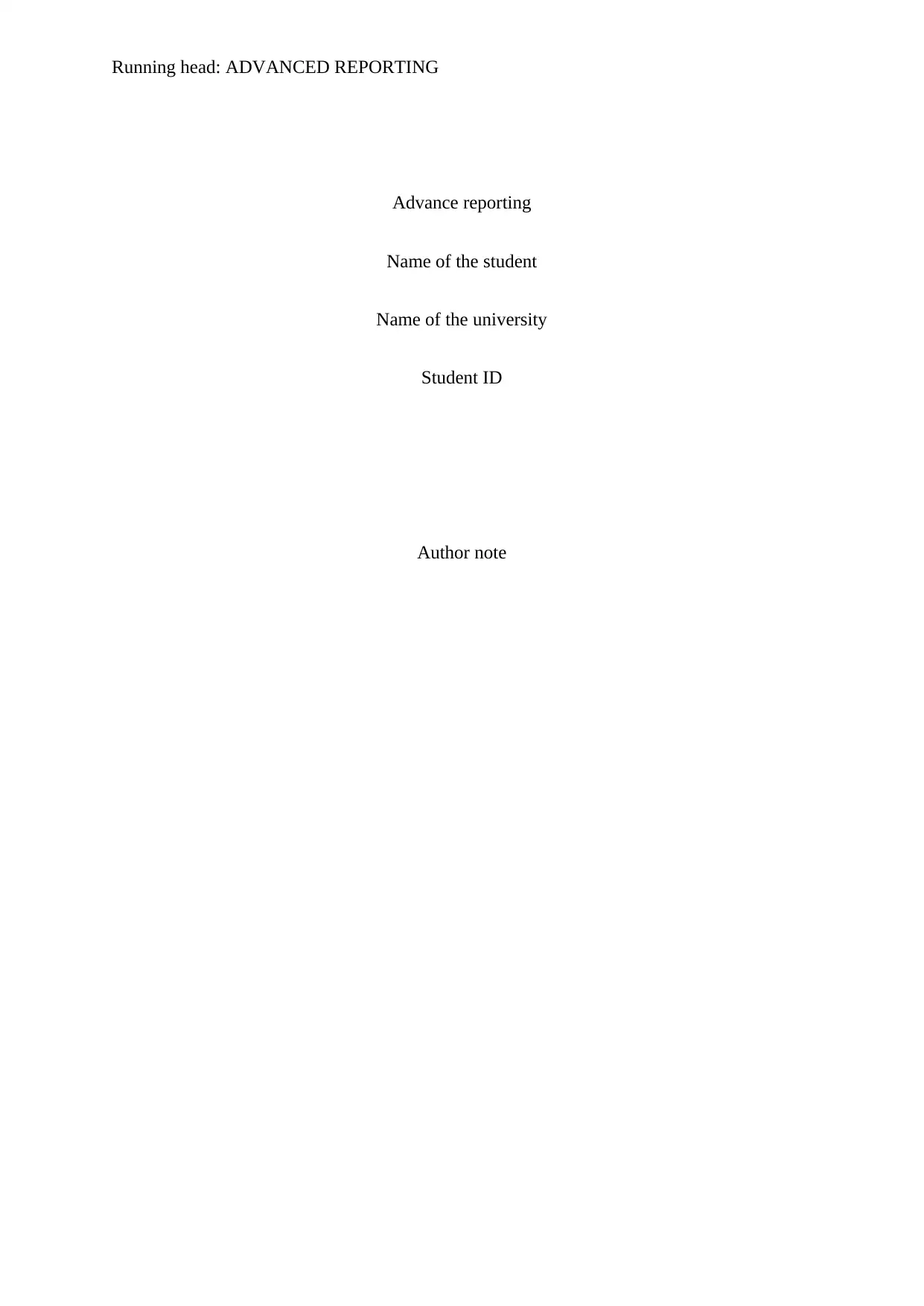
Running head: ADVANCED REPORTING
Advance reporting
Name of the student
Name of the university
Student ID
Author note
Advance reporting
Name of the student
Name of the university
Student ID
Author note
Secure Best Marks with AI Grader
Need help grading? Try our AI Grader for instant feedback on your assignments.
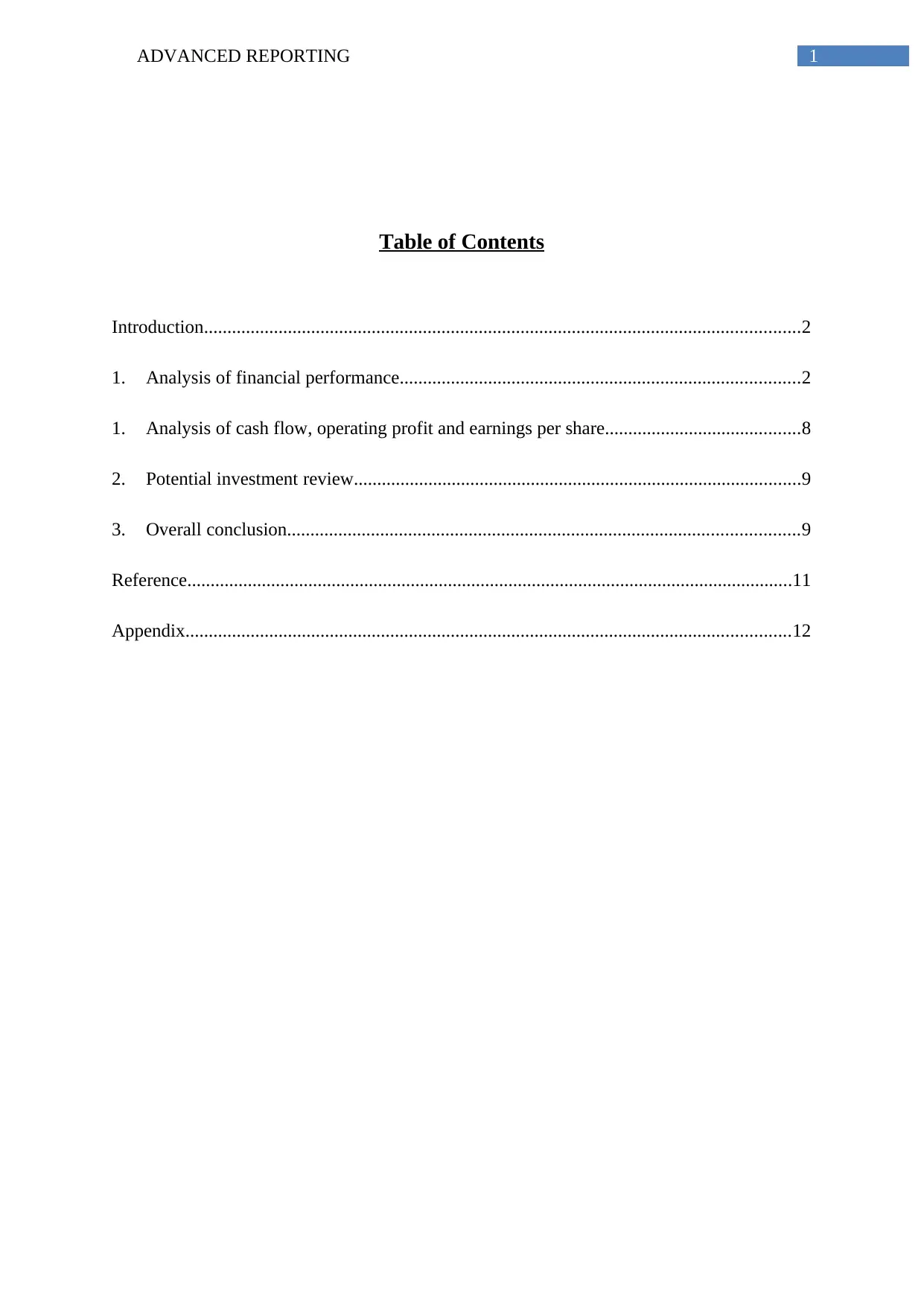
1ADVANCED REPORTING
Table of Contents
Introduction................................................................................................................................2
1. Analysis of financial performance......................................................................................2
1. Analysis of cash flow, operating profit and earnings per share..........................................8
2. Potential investment review................................................................................................9
3. Overall conclusion..............................................................................................................9
Reference..................................................................................................................................11
Appendix..................................................................................................................................12
Table of Contents
Introduction................................................................................................................................2
1. Analysis of financial performance......................................................................................2
1. Analysis of cash flow, operating profit and earnings per share..........................................8
2. Potential investment review................................................................................................9
3. Overall conclusion..............................................................................................................9
Reference..................................................................................................................................11
Appendix..................................................................................................................................12

2ADVANCED REPORTING
Introduction
Ryan air is the largest and low fare airline that is based in Ireland. The company is a
public listed company and trades in New York, London and Dublin. Ryan air is committed
towards low cost airfare and it is introducing competition for the growing airline market in
Europe it has the potential to offer the passengers with the lowest fare in the industry and
high efficiency and low cost in the airport. The company started its operation during 1985
and launched 15 flights per day day between London Gatwik Airport Waterford and Turbine
support. Despite of being successful, Ryanair is committed to lower airfare, maximization of
low fare seats and increasing the service frequency. Direct competitors of the company are
various airlines that includes Scandanavian airline, Lufthansa, Alitalia, Air France and Aer
Lingus. However, the company’s unparalleled low fares, comfortable in-flight service, high
frequency, on time flights have helped it to win continuous increase in customer number and
supports from them (Ryanair.com 2018).
1. Analysis of financial performance
Ratio calculation
Ratio Formula 2017 2016
Profitability Ratio
Operating profit margin Operating profit / sales *100 23.08 22.34
Net profit margin Net profit / Sales *100 19.79 23.85
Return on capital employed PBIT/ Capital employed * 100 17.09 18.60
Liquidity ratios
Current ratio Current assets/Current Liabilities 1.56 1.43
Quick ratio (Current assets -Stock)/ Current liabilities 1.56 1.43
Solvency ratios
Debt to equity ratios Total liabilities/Shareholder’s equity 1.71 2.12
Interest coverage ratio Profit before interest and tax / Interest
payable 22.83 20.54
Activity ratios
Trade receivable turnover Sales/average accounts receivable 110.43 103.58
Introduction
Ryan air is the largest and low fare airline that is based in Ireland. The company is a
public listed company and trades in New York, London and Dublin. Ryan air is committed
towards low cost airfare and it is introducing competition for the growing airline market in
Europe it has the potential to offer the passengers with the lowest fare in the industry and
high efficiency and low cost in the airport. The company started its operation during 1985
and launched 15 flights per day day between London Gatwik Airport Waterford and Turbine
support. Despite of being successful, Ryanair is committed to lower airfare, maximization of
low fare seats and increasing the service frequency. Direct competitors of the company are
various airlines that includes Scandanavian airline, Lufthansa, Alitalia, Air France and Aer
Lingus. However, the company’s unparalleled low fares, comfortable in-flight service, high
frequency, on time flights have helped it to win continuous increase in customer number and
supports from them (Ryanair.com 2018).
1. Analysis of financial performance
Ratio calculation
Ratio Formula 2017 2016
Profitability Ratio
Operating profit margin Operating profit / sales *100 23.08 22.34
Net profit margin Net profit / Sales *100 19.79 23.85
Return on capital employed PBIT/ Capital employed * 100 17.09 18.60
Liquidity ratios
Current ratio Current assets/Current Liabilities 1.56 1.43
Quick ratio (Current assets -Stock)/ Current liabilities 1.56 1.43
Solvency ratios
Debt to equity ratios Total liabilities/Shareholder’s equity 1.71 2.12
Interest coverage ratio Profit before interest and tax / Interest
payable 22.83 20.54
Activity ratios
Trade receivable turnover Sales/average accounts receivable 110.43 103.58
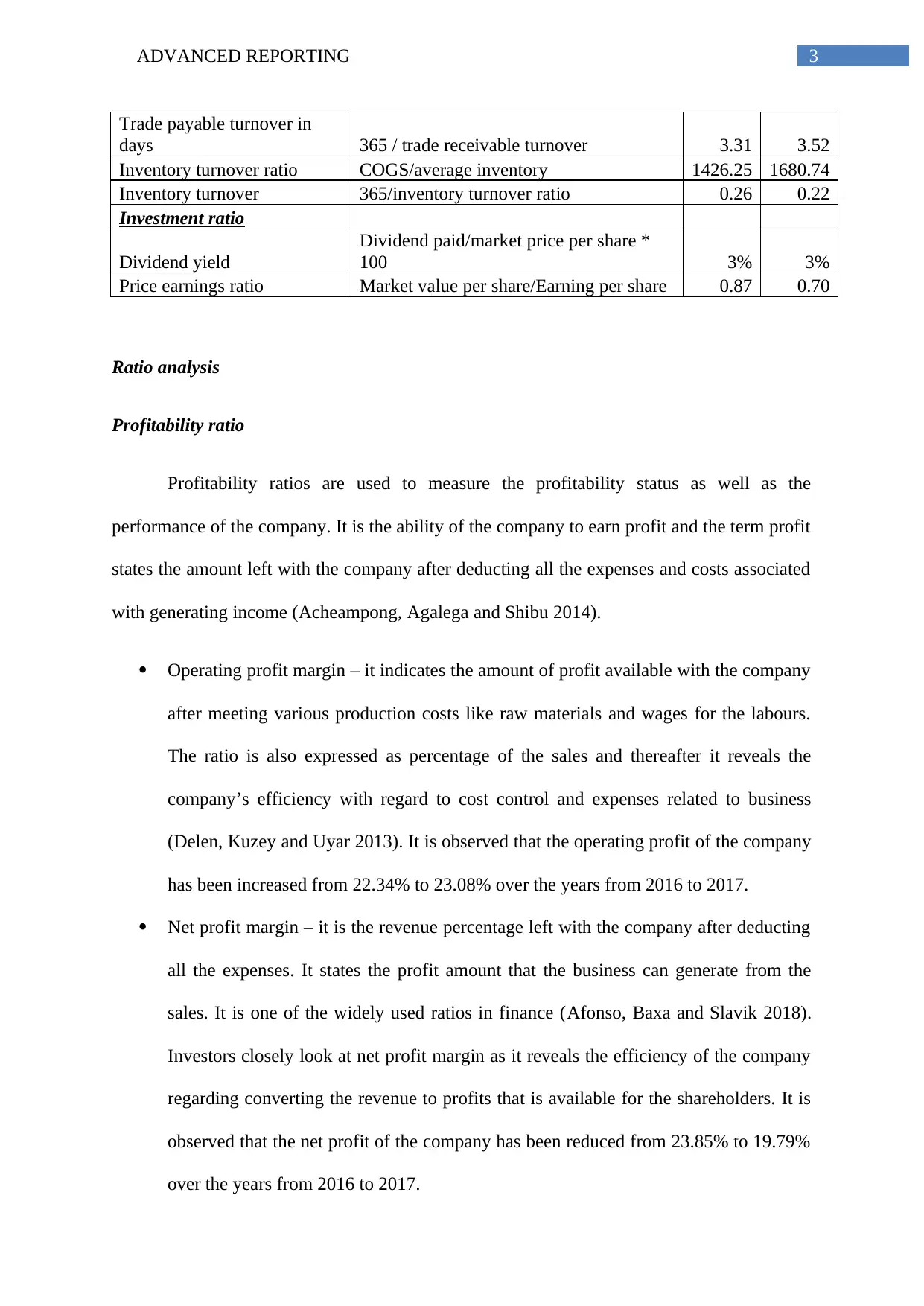
3ADVANCED REPORTING
Trade payable turnover in
days 365 / trade receivable turnover 3.31 3.52
Inventory turnover ratio COGS/average inventory 1426.25 1680.74
Inventory turnover 365/inventory turnover ratio 0.26 0.22
Investment ratio
Dividend yield
Dividend paid/market price per share *
100 3% 3%
Price earnings ratio Market value per share/Earning per share 0.87 0.70
Ratio analysis
Profitability ratio
Profitability ratios are used to measure the profitability status as well as the
performance of the company. It is the ability of the company to earn profit and the term profit
states the amount left with the company after deducting all the expenses and costs associated
with generating income (Acheampong, Agalega and Shibu 2014).
Operating profit margin – it indicates the amount of profit available with the company
after meeting various production costs like raw materials and wages for the labours.
The ratio is also expressed as percentage of the sales and thereafter it reveals the
company’s efficiency with regard to cost control and expenses related to business
(Delen, Kuzey and Uyar 2013). It is observed that the operating profit of the company
has been increased from 22.34% to 23.08% over the years from 2016 to 2017.
Net profit margin – it is the revenue percentage left with the company after deducting
all the expenses. It states the profit amount that the business can generate from the
sales. It is one of the widely used ratios in finance (Afonso, Baxa and Slavik 2018).
Investors closely look at net profit margin as it reveals the efficiency of the company
regarding converting the revenue to profits that is available for the shareholders. It is
observed that the net profit of the company has been reduced from 23.85% to 19.79%
over the years from 2016 to 2017.
Trade payable turnover in
days 365 / trade receivable turnover 3.31 3.52
Inventory turnover ratio COGS/average inventory 1426.25 1680.74
Inventory turnover 365/inventory turnover ratio 0.26 0.22
Investment ratio
Dividend yield
Dividend paid/market price per share *
100 3% 3%
Price earnings ratio Market value per share/Earning per share 0.87 0.70
Ratio analysis
Profitability ratio
Profitability ratios are used to measure the profitability status as well as the
performance of the company. It is the ability of the company to earn profit and the term profit
states the amount left with the company after deducting all the expenses and costs associated
with generating income (Acheampong, Agalega and Shibu 2014).
Operating profit margin – it indicates the amount of profit available with the company
after meeting various production costs like raw materials and wages for the labours.
The ratio is also expressed as percentage of the sales and thereafter it reveals the
company’s efficiency with regard to cost control and expenses related to business
(Delen, Kuzey and Uyar 2013). It is observed that the operating profit of the company
has been increased from 22.34% to 23.08% over the years from 2016 to 2017.
Net profit margin – it is the revenue percentage left with the company after deducting
all the expenses. It states the profit amount that the business can generate from the
sales. It is one of the widely used ratios in finance (Afonso, Baxa and Slavik 2018).
Investors closely look at net profit margin as it reveals the efficiency of the company
regarding converting the revenue to profits that is available for the shareholders. It is
observed that the net profit of the company has been reduced from 23.85% to 19.79%
over the years from 2016 to 2017.
Secure Best Marks with AI Grader
Need help grading? Try our AI Grader for instant feedback on your assignments.
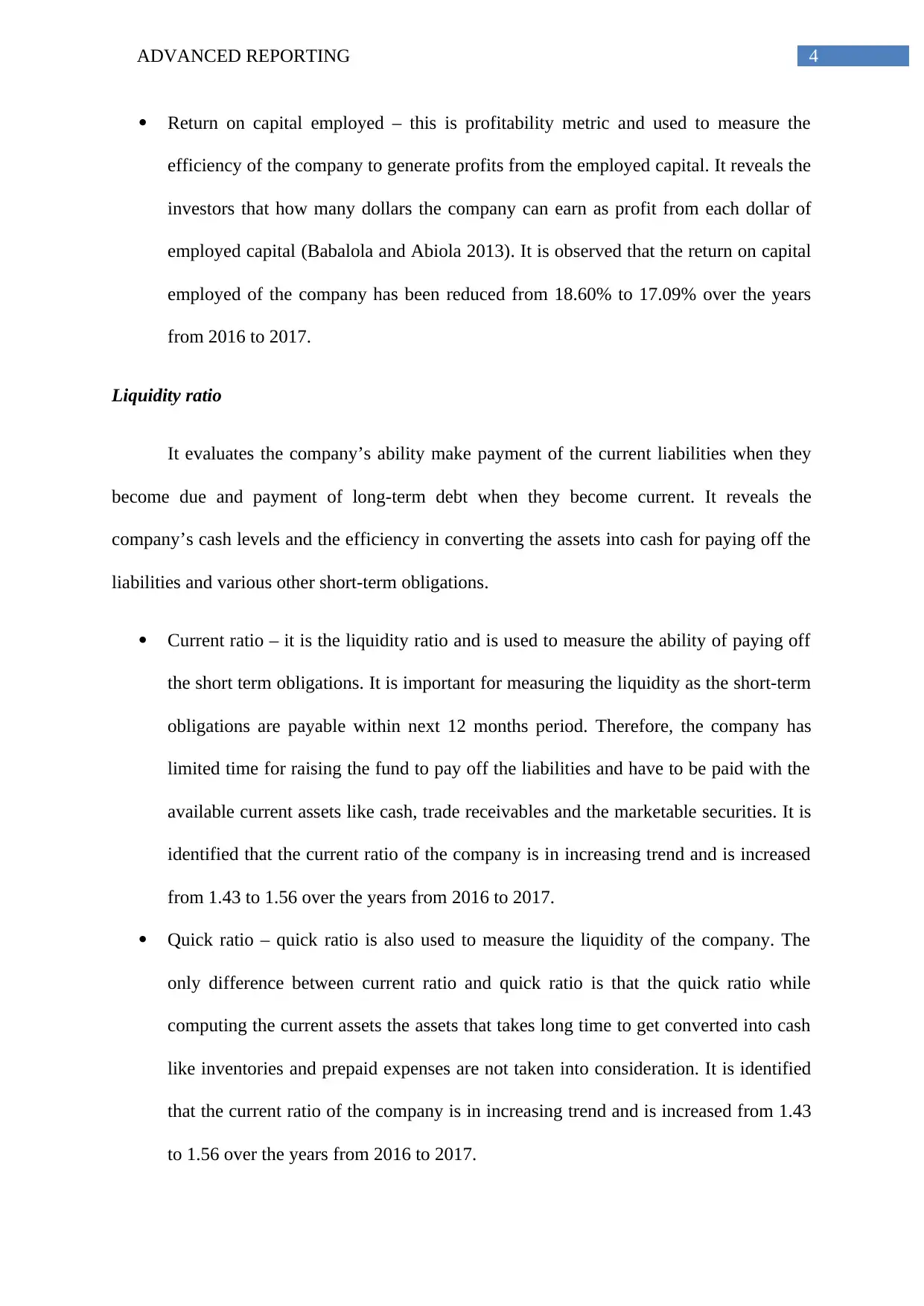
4ADVANCED REPORTING
Return on capital employed – this is profitability metric and used to measure the
efficiency of the company to generate profits from the employed capital. It reveals the
investors that how many dollars the company can earn as profit from each dollar of
employed capital (Babalola and Abiola 2013). It is observed that the return on capital
employed of the company has been reduced from 18.60% to 17.09% over the years
from 2016 to 2017.
Liquidity ratio
It evaluates the company’s ability make payment of the current liabilities when they
become due and payment of long-term debt when they become current. It reveals the
company’s cash levels and the efficiency in converting the assets into cash for paying off the
liabilities and various other short-term obligations.
Current ratio – it is the liquidity ratio and is used to measure the ability of paying off
the short term obligations. It is important for measuring the liquidity as the short-term
obligations are payable within next 12 months period. Therefore, the company has
limited time for raising the fund to pay off the liabilities and have to be paid with the
available current assets like cash, trade receivables and the marketable securities. It is
identified that the current ratio of the company is in increasing trend and is increased
from 1.43 to 1.56 over the years from 2016 to 2017.
Quick ratio – quick ratio is also used to measure the liquidity of the company. The
only difference between current ratio and quick ratio is that the quick ratio while
computing the current assets the assets that takes long time to get converted into cash
like inventories and prepaid expenses are not taken into consideration. It is identified
that the current ratio of the company is in increasing trend and is increased from 1.43
to 1.56 over the years from 2016 to 2017.
Return on capital employed – this is profitability metric and used to measure the
efficiency of the company to generate profits from the employed capital. It reveals the
investors that how many dollars the company can earn as profit from each dollar of
employed capital (Babalola and Abiola 2013). It is observed that the return on capital
employed of the company has been reduced from 18.60% to 17.09% over the years
from 2016 to 2017.
Liquidity ratio
It evaluates the company’s ability make payment of the current liabilities when they
become due and payment of long-term debt when they become current. It reveals the
company’s cash levels and the efficiency in converting the assets into cash for paying off the
liabilities and various other short-term obligations.
Current ratio – it is the liquidity ratio and is used to measure the ability of paying off
the short term obligations. It is important for measuring the liquidity as the short-term
obligations are payable within next 12 months period. Therefore, the company has
limited time for raising the fund to pay off the liabilities and have to be paid with the
available current assets like cash, trade receivables and the marketable securities. It is
identified that the current ratio of the company is in increasing trend and is increased
from 1.43 to 1.56 over the years from 2016 to 2017.
Quick ratio – quick ratio is also used to measure the liquidity of the company. The
only difference between current ratio and quick ratio is that the quick ratio while
computing the current assets the assets that takes long time to get converted into cash
like inventories and prepaid expenses are not taken into consideration. It is identified
that the current ratio of the company is in increasing trend and is increased from 1.43
to 1.56 over the years from 2016 to 2017.
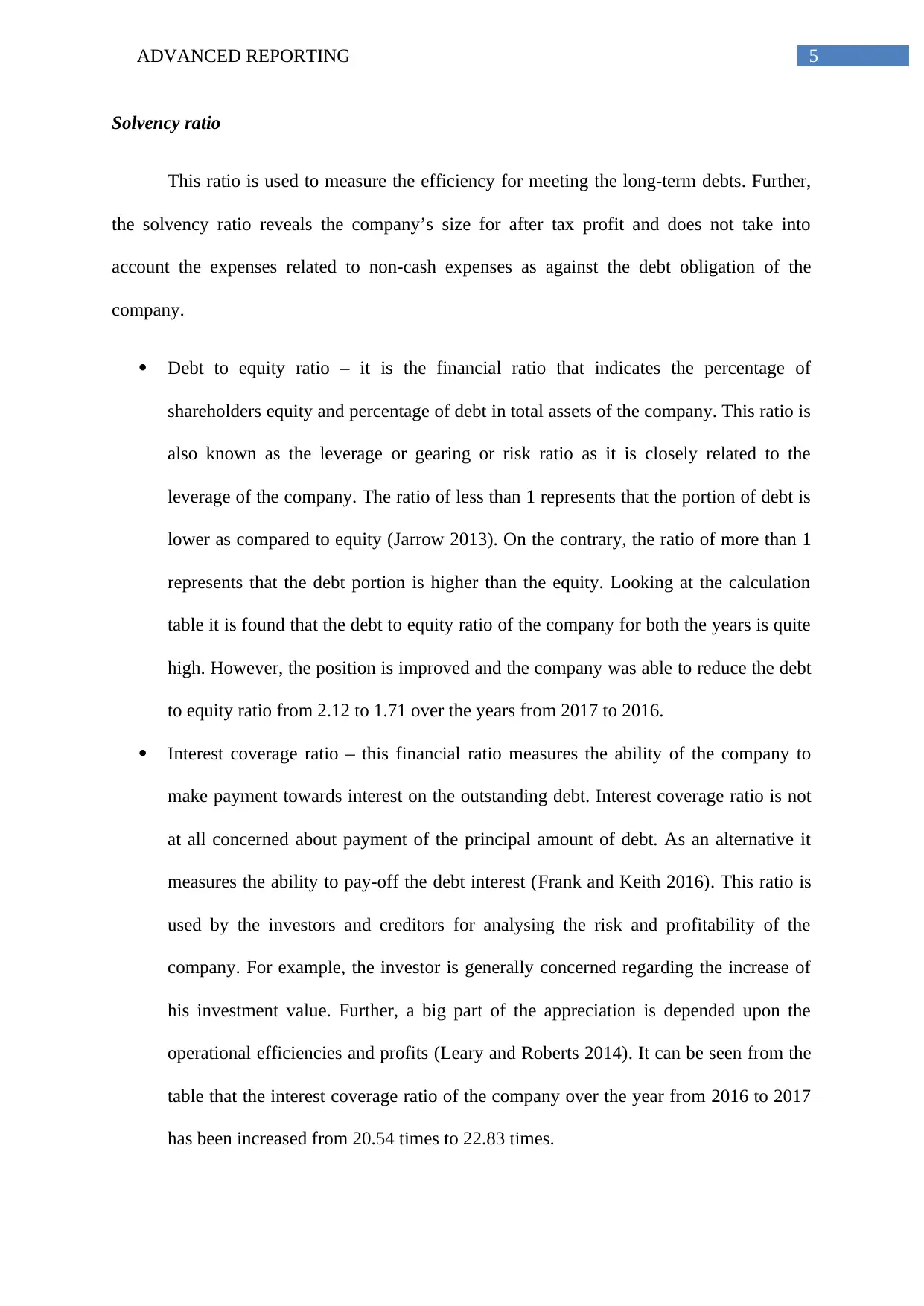
5ADVANCED REPORTING
Solvency ratio
This ratio is used to measure the efficiency for meeting the long-term debts. Further,
the solvency ratio reveals the company’s size for after tax profit and does not take into
account the expenses related to non-cash expenses as against the debt obligation of the
company.
Debt to equity ratio – it is the financial ratio that indicates the percentage of
shareholders equity and percentage of debt in total assets of the company. This ratio is
also known as the leverage or gearing or risk ratio as it is closely related to the
leverage of the company. The ratio of less than 1 represents that the portion of debt is
lower as compared to equity (Jarrow 2013). On the contrary, the ratio of more than 1
represents that the debt portion is higher than the equity. Looking at the calculation
table it is found that the debt to equity ratio of the company for both the years is quite
high. However, the position is improved and the company was able to reduce the debt
to equity ratio from 2.12 to 1.71 over the years from 2017 to 2016.
Interest coverage ratio – this financial ratio measures the ability of the company to
make payment towards interest on the outstanding debt. Interest coverage ratio is not
at all concerned about payment of the principal amount of debt. As an alternative it
measures the ability to pay-off the debt interest (Frank and Keith 2016). This ratio is
used by the investors and creditors for analysing the risk and profitability of the
company. For example, the investor is generally concerned regarding the increase of
his investment value. Further, a big part of the appreciation is depended upon the
operational efficiencies and profits (Leary and Roberts 2014). It can be seen from the
table that the interest coverage ratio of the company over the year from 2016 to 2017
has been increased from 20.54 times to 22.83 times.
Solvency ratio
This ratio is used to measure the efficiency for meeting the long-term debts. Further,
the solvency ratio reveals the company’s size for after tax profit and does not take into
account the expenses related to non-cash expenses as against the debt obligation of the
company.
Debt to equity ratio – it is the financial ratio that indicates the percentage of
shareholders equity and percentage of debt in total assets of the company. This ratio is
also known as the leverage or gearing or risk ratio as it is closely related to the
leverage of the company. The ratio of less than 1 represents that the portion of debt is
lower as compared to equity (Jarrow 2013). On the contrary, the ratio of more than 1
represents that the debt portion is higher than the equity. Looking at the calculation
table it is found that the debt to equity ratio of the company for both the years is quite
high. However, the position is improved and the company was able to reduce the debt
to equity ratio from 2.12 to 1.71 over the years from 2017 to 2016.
Interest coverage ratio – this financial ratio measures the ability of the company to
make payment towards interest on the outstanding debt. Interest coverage ratio is not
at all concerned about payment of the principal amount of debt. As an alternative it
measures the ability to pay-off the debt interest (Frank and Keith 2016). This ratio is
used by the investors and creditors for analysing the risk and profitability of the
company. For example, the investor is generally concerned regarding the increase of
his investment value. Further, a big part of the appreciation is depended upon the
operational efficiencies and profits (Leary and Roberts 2014). It can be seen from the
table that the interest coverage ratio of the company over the year from 2016 to 2017
has been increased from 20.54 times to 22.83 times.
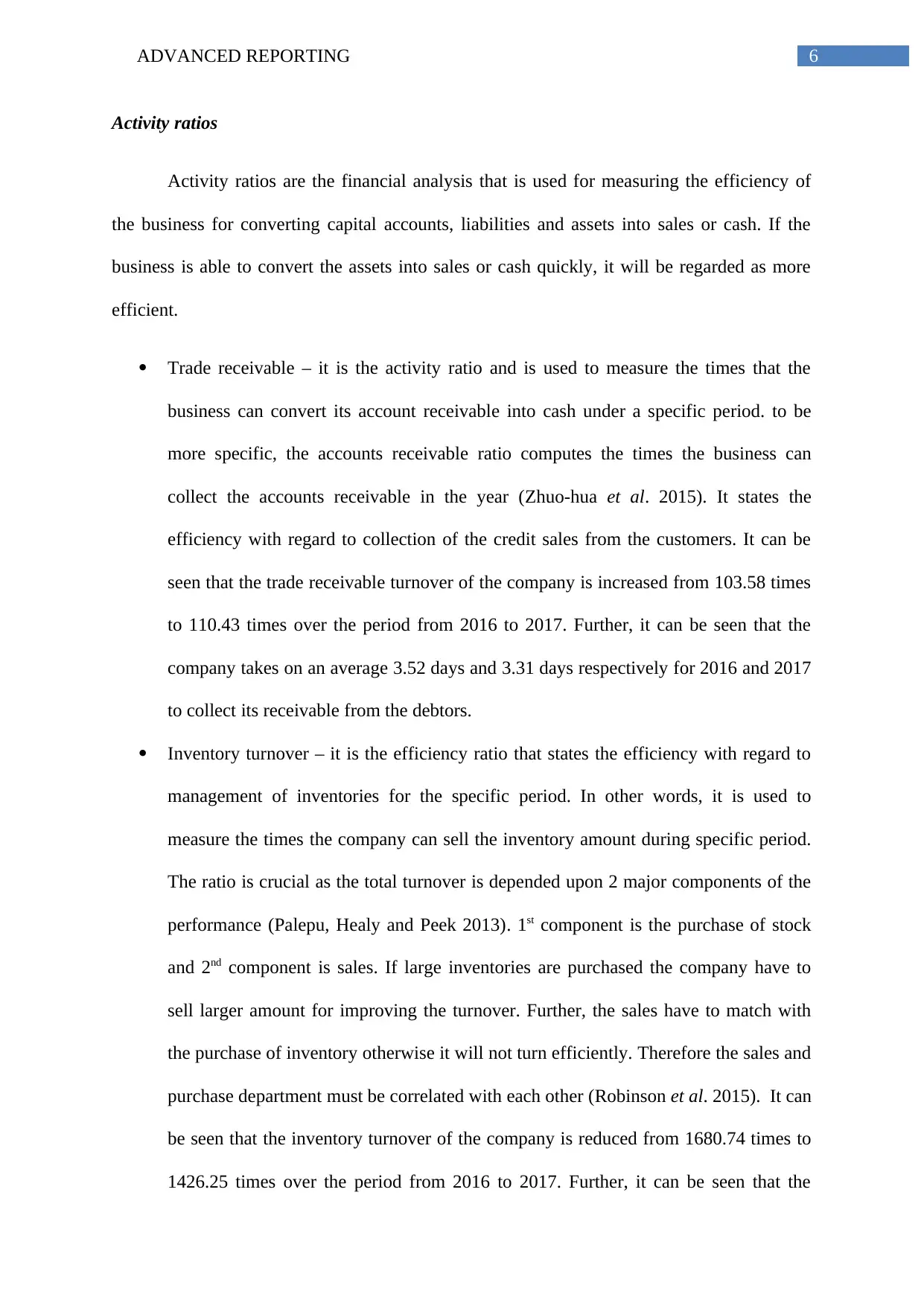
6ADVANCED REPORTING
Activity ratios
Activity ratios are the financial analysis that is used for measuring the efficiency of
the business for converting capital accounts, liabilities and assets into sales or cash. If the
business is able to convert the assets into sales or cash quickly, it will be regarded as more
efficient.
Trade receivable – it is the activity ratio and is used to measure the times that the
business can convert its account receivable into cash under a specific period. to be
more specific, the accounts receivable ratio computes the times the business can
collect the accounts receivable in the year (Zhuo-hua et al. 2015). It states the
efficiency with regard to collection of the credit sales from the customers. It can be
seen that the trade receivable turnover of the company is increased from 103.58 times
to 110.43 times over the period from 2016 to 2017. Further, it can be seen that the
company takes on an average 3.52 days and 3.31 days respectively for 2016 and 2017
to collect its receivable from the debtors.
Inventory turnover – it is the efficiency ratio that states the efficiency with regard to
management of inventories for the specific period. In other words, it is used to
measure the times the company can sell the inventory amount during specific period.
The ratio is crucial as the total turnover is depended upon 2 major components of the
performance (Palepu, Healy and Peek 2013). 1st component is the purchase of stock
and 2nd component is sales. If large inventories are purchased the company have to
sell larger amount for improving the turnover. Further, the sales have to match with
the purchase of inventory otherwise it will not turn efficiently. Therefore the sales and
purchase department must be correlated with each other (Robinson et al. 2015). It can
be seen that the inventory turnover of the company is reduced from 1680.74 times to
1426.25 times over the period from 2016 to 2017. Further, it can be seen that the
Activity ratios
Activity ratios are the financial analysis that is used for measuring the efficiency of
the business for converting capital accounts, liabilities and assets into sales or cash. If the
business is able to convert the assets into sales or cash quickly, it will be regarded as more
efficient.
Trade receivable – it is the activity ratio and is used to measure the times that the
business can convert its account receivable into cash under a specific period. to be
more specific, the accounts receivable ratio computes the times the business can
collect the accounts receivable in the year (Zhuo-hua et al. 2015). It states the
efficiency with regard to collection of the credit sales from the customers. It can be
seen that the trade receivable turnover of the company is increased from 103.58 times
to 110.43 times over the period from 2016 to 2017. Further, it can be seen that the
company takes on an average 3.52 days and 3.31 days respectively for 2016 and 2017
to collect its receivable from the debtors.
Inventory turnover – it is the efficiency ratio that states the efficiency with regard to
management of inventories for the specific period. In other words, it is used to
measure the times the company can sell the inventory amount during specific period.
The ratio is crucial as the total turnover is depended upon 2 major components of the
performance (Palepu, Healy and Peek 2013). 1st component is the purchase of stock
and 2nd component is sales. If large inventories are purchased the company have to
sell larger amount for improving the turnover. Further, the sales have to match with
the purchase of inventory otherwise it will not turn efficiently. Therefore the sales and
purchase department must be correlated with each other (Robinson et al. 2015). It can
be seen that the inventory turnover of the company is reduced from 1680.74 times to
1426.25 times over the period from 2016 to 2017. Further, it can be seen that the
Paraphrase This Document
Need a fresh take? Get an instant paraphrase of this document with our AI Paraphraser
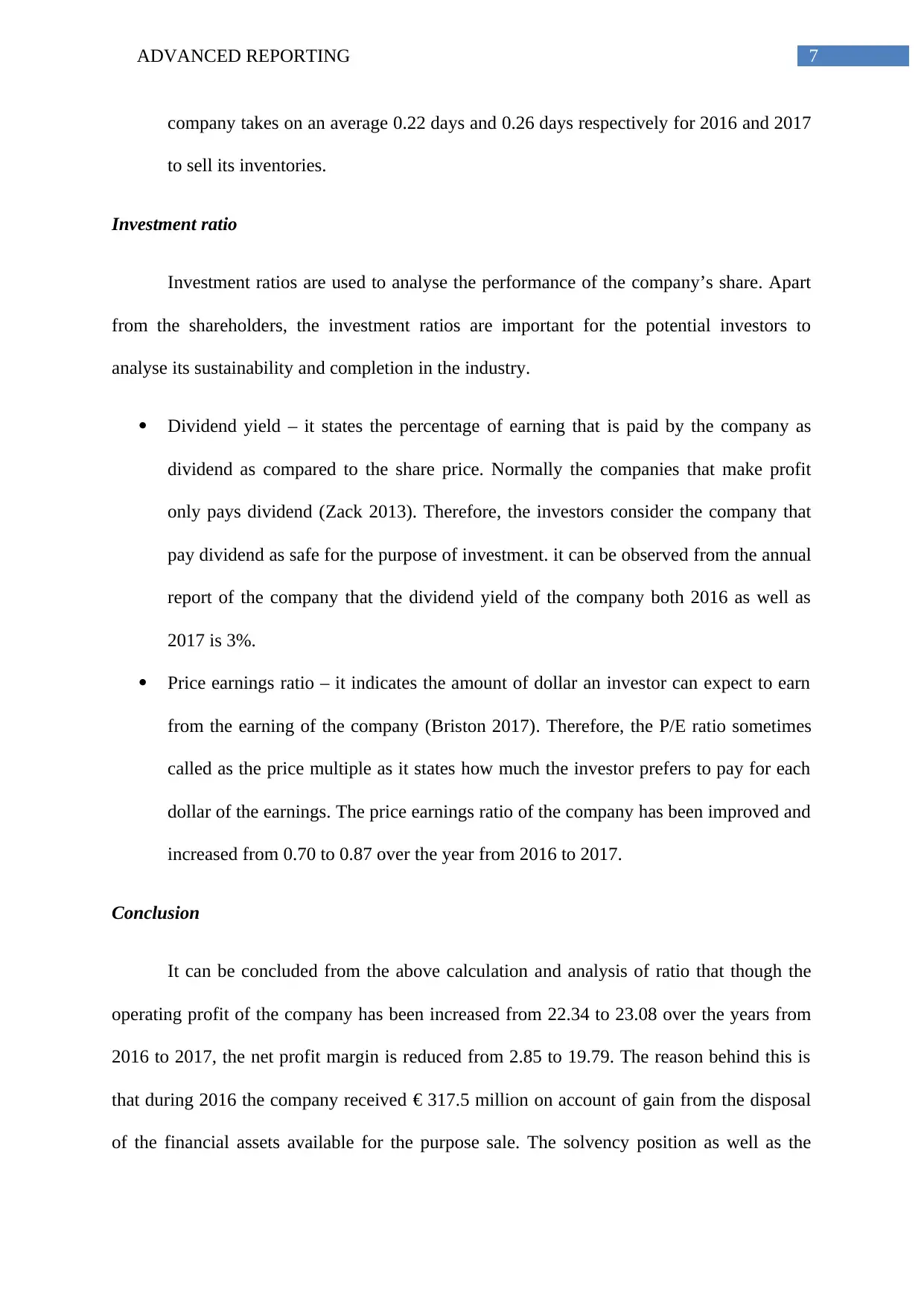
7ADVANCED REPORTING
company takes on an average 0.22 days and 0.26 days respectively for 2016 and 2017
to sell its inventories.
Investment ratio
Investment ratios are used to analyse the performance of the company’s share. Apart
from the shareholders, the investment ratios are important for the potential investors to
analyse its sustainability and completion in the industry.
Dividend yield – it states the percentage of earning that is paid by the company as
dividend as compared to the share price. Normally the companies that make profit
only pays dividend (Zack 2013). Therefore, the investors consider the company that
pay dividend as safe for the purpose of investment. it can be observed from the annual
report of the company that the dividend yield of the company both 2016 as well as
2017 is 3%.
Price earnings ratio – it indicates the amount of dollar an investor can expect to earn
from the earning of the company (Briston 2017). Therefore, the P/E ratio sometimes
called as the price multiple as it states how much the investor prefers to pay for each
dollar of the earnings. The price earnings ratio of the company has been improved and
increased from 0.70 to 0.87 over the year from 2016 to 2017.
Conclusion
It can be concluded from the above calculation and analysis of ratio that though the
operating profit of the company has been increased from 22.34 to 23.08 over the years from
2016 to 2017, the net profit margin is reduced from 2.85 to 19.79. The reason behind this is
that during 2016 the company received € 317.5 million on account of gain from the disposal
of the financial assets available for the purpose sale. The solvency position as well as the
company takes on an average 0.22 days and 0.26 days respectively for 2016 and 2017
to sell its inventories.
Investment ratio
Investment ratios are used to analyse the performance of the company’s share. Apart
from the shareholders, the investment ratios are important for the potential investors to
analyse its sustainability and completion in the industry.
Dividend yield – it states the percentage of earning that is paid by the company as
dividend as compared to the share price. Normally the companies that make profit
only pays dividend (Zack 2013). Therefore, the investors consider the company that
pay dividend as safe for the purpose of investment. it can be observed from the annual
report of the company that the dividend yield of the company both 2016 as well as
2017 is 3%.
Price earnings ratio – it indicates the amount of dollar an investor can expect to earn
from the earning of the company (Briston 2017). Therefore, the P/E ratio sometimes
called as the price multiple as it states how much the investor prefers to pay for each
dollar of the earnings. The price earnings ratio of the company has been improved and
increased from 0.70 to 0.87 over the year from 2016 to 2017.
Conclusion
It can be concluded from the above calculation and analysis of ratio that though the
operating profit of the company has been increased from 22.34 to 23.08 over the years from
2016 to 2017, the net profit margin is reduced from 2.85 to 19.79. The reason behind this is
that during 2016 the company received € 317.5 million on account of gain from the disposal
of the financial assets available for the purpose sale. The solvency position as well as the
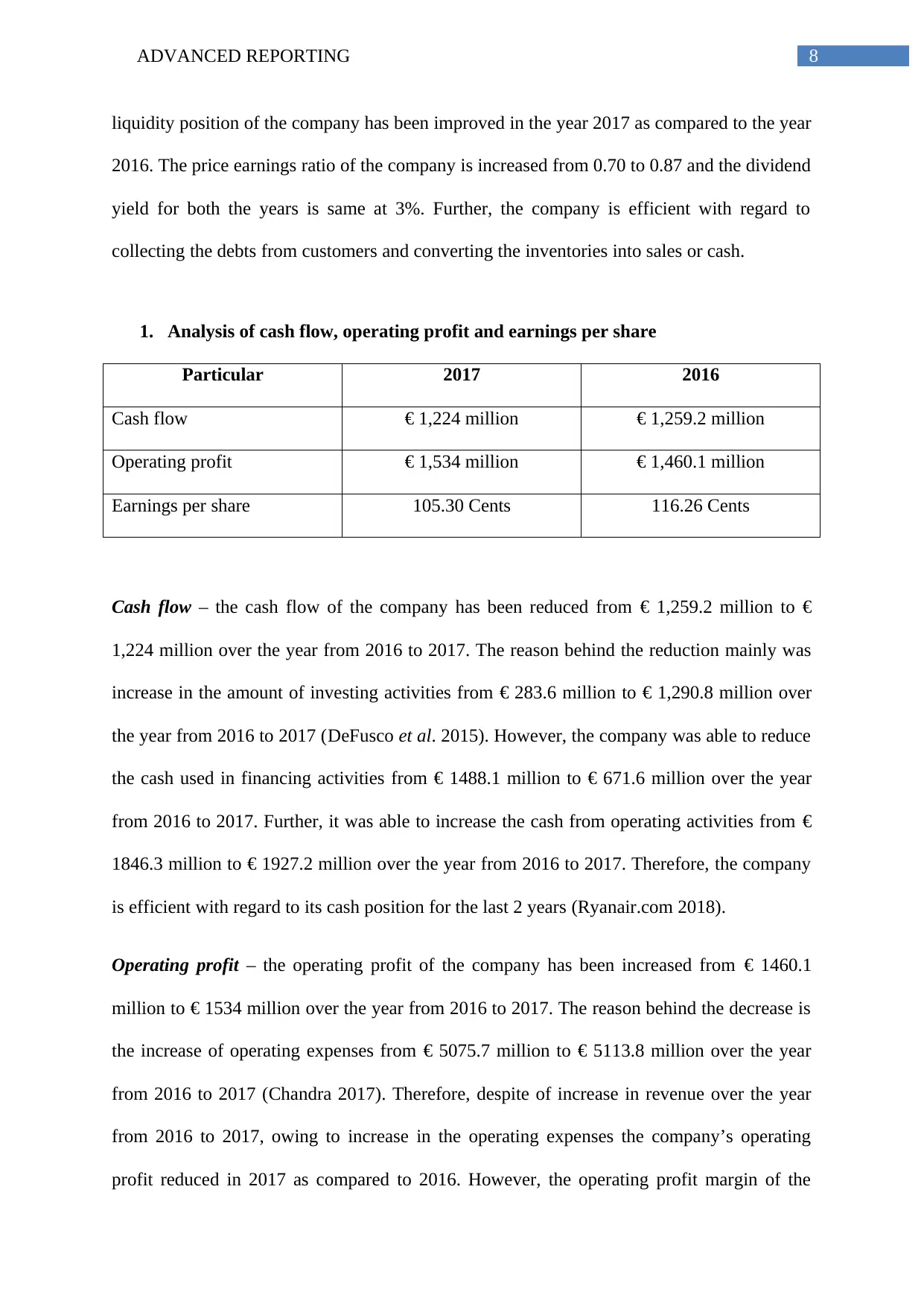
8ADVANCED REPORTING
liquidity position of the company has been improved in the year 2017 as compared to the year
2016. The price earnings ratio of the company is increased from 0.70 to 0.87 and the dividend
yield for both the years is same at 3%. Further, the company is efficient with regard to
collecting the debts from customers and converting the inventories into sales or cash.
1. Analysis of cash flow, operating profit and earnings per share
Particular 2017 2016
Cash flow € 1,224 million € 1,259.2 million
Operating profit € 1,534 million € 1,460.1 million
Earnings per share 105.30 Cents 116.26 Cents
Cash flow – the cash flow of the company has been reduced from € 1,259.2 million to €
1,224 million over the year from 2016 to 2017. The reason behind the reduction mainly was
increase in the amount of investing activities from € 283.6 million to € 1,290.8 million over
the year from 2016 to 2017 (DeFusco et al. 2015). However, the company was able to reduce
the cash used in financing activities from € 1488.1 million to € 671.6 million over the year
from 2016 to 2017. Further, it was able to increase the cash from operating activities from €
1846.3 million to € 1927.2 million over the year from 2016 to 2017. Therefore, the company
is efficient with regard to its cash position for the last 2 years (Ryanair.com 2018).
Operating profit – the operating profit of the company has been increased from € 1460.1
million to € 1534 million over the year from 2016 to 2017. The reason behind the decrease is
the increase of operating expenses from € 5075.7 million to € 5113.8 million over the year
from 2016 to 2017 (Chandra 2017). Therefore, despite of increase in revenue over the year
from 2016 to 2017, owing to increase in the operating expenses the company’s operating
profit reduced in 2017 as compared to 2016. However, the operating profit margin of the
liquidity position of the company has been improved in the year 2017 as compared to the year
2016. The price earnings ratio of the company is increased from 0.70 to 0.87 and the dividend
yield for both the years is same at 3%. Further, the company is efficient with regard to
collecting the debts from customers and converting the inventories into sales or cash.
1. Analysis of cash flow, operating profit and earnings per share
Particular 2017 2016
Cash flow € 1,224 million € 1,259.2 million
Operating profit € 1,534 million € 1,460.1 million
Earnings per share 105.30 Cents 116.26 Cents
Cash flow – the cash flow of the company has been reduced from € 1,259.2 million to €
1,224 million over the year from 2016 to 2017. The reason behind the reduction mainly was
increase in the amount of investing activities from € 283.6 million to € 1,290.8 million over
the year from 2016 to 2017 (DeFusco et al. 2015). However, the company was able to reduce
the cash used in financing activities from € 1488.1 million to € 671.6 million over the year
from 2016 to 2017. Further, it was able to increase the cash from operating activities from €
1846.3 million to € 1927.2 million over the year from 2016 to 2017. Therefore, the company
is efficient with regard to its cash position for the last 2 years (Ryanair.com 2018).
Operating profit – the operating profit of the company has been increased from € 1460.1
million to € 1534 million over the year from 2016 to 2017. The reason behind the decrease is
the increase of operating expenses from € 5075.7 million to € 5113.8 million over the year
from 2016 to 2017 (Chandra 2017). Therefore, despite of increase in revenue over the year
from 2016 to 2017, owing to increase in the operating expenses the company’s operating
profit reduced in 2017 as compared to 2016. However, the operating profit margin of the
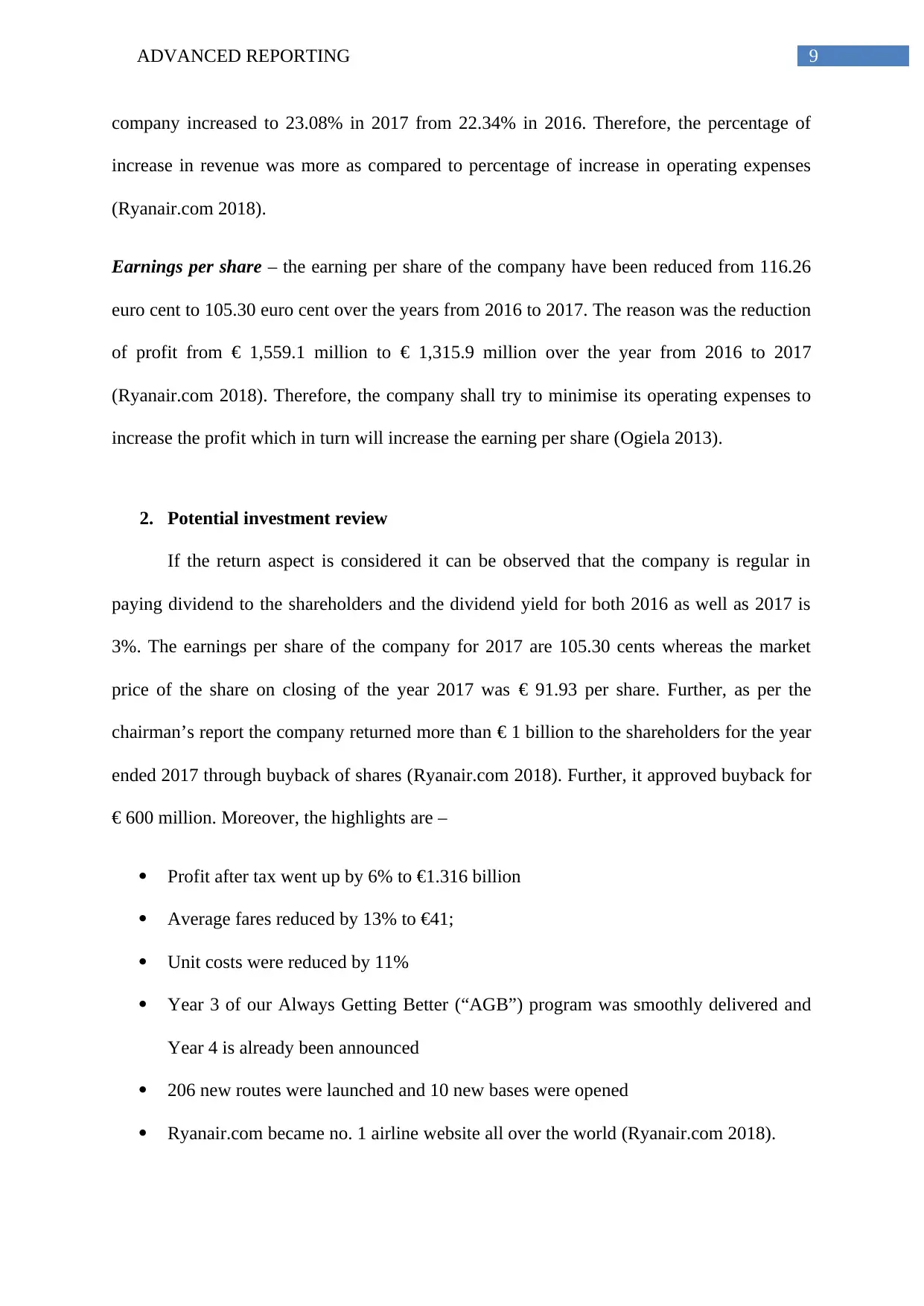
9ADVANCED REPORTING
company increased to 23.08% in 2017 from 22.34% in 2016. Therefore, the percentage of
increase in revenue was more as compared to percentage of increase in operating expenses
(Ryanair.com 2018).
Earnings per share – the earning per share of the company have been reduced from 116.26
euro cent to 105.30 euro cent over the years from 2016 to 2017. The reason was the reduction
of profit from € 1,559.1 million to € 1,315.9 million over the year from 2016 to 2017
(Ryanair.com 2018). Therefore, the company shall try to minimise its operating expenses to
increase the profit which in turn will increase the earning per share (Ogiela 2013).
2. Potential investment review
If the return aspect is considered it can be observed that the company is regular in
paying dividend to the shareholders and the dividend yield for both 2016 as well as 2017 is
3%. The earnings per share of the company for 2017 are 105.30 cents whereas the market
price of the share on closing of the year 2017 was € 91.93 per share. Further, as per the
chairman’s report the company returned more than € 1 billion to the shareholders for the year
ended 2017 through buyback of shares (Ryanair.com 2018). Further, it approved buyback for
€ 600 million. Moreover, the highlights are –
Profit after tax went up by 6% to €1.316 billion
Average fares reduced by 13% to €41;
Unit costs were reduced by 11%
Year 3 of our Always Getting Better (“AGB”) program was smoothly delivered and
Year 4 is already been announced
206 new routes were launched and 10 new bases were opened
Ryanair.com became no. 1 airline website all over the world (Ryanair.com 2018).
company increased to 23.08% in 2017 from 22.34% in 2016. Therefore, the percentage of
increase in revenue was more as compared to percentage of increase in operating expenses
(Ryanair.com 2018).
Earnings per share – the earning per share of the company have been reduced from 116.26
euro cent to 105.30 euro cent over the years from 2016 to 2017. The reason was the reduction
of profit from € 1,559.1 million to € 1,315.9 million over the year from 2016 to 2017
(Ryanair.com 2018). Therefore, the company shall try to minimise its operating expenses to
increase the profit which in turn will increase the earning per share (Ogiela 2013).
2. Potential investment review
If the return aspect is considered it can be observed that the company is regular in
paying dividend to the shareholders and the dividend yield for both 2016 as well as 2017 is
3%. The earnings per share of the company for 2017 are 105.30 cents whereas the market
price of the share on closing of the year 2017 was € 91.93 per share. Further, as per the
chairman’s report the company returned more than € 1 billion to the shareholders for the year
ended 2017 through buyback of shares (Ryanair.com 2018). Further, it approved buyback for
€ 600 million. Moreover, the highlights are –
Profit after tax went up by 6% to €1.316 billion
Average fares reduced by 13% to €41;
Unit costs were reduced by 11%
Year 3 of our Always Getting Better (“AGB”) program was smoothly delivered and
Year 4 is already been announced
206 new routes were launched and 10 new bases were opened
Ryanair.com became no. 1 airline website all over the world (Ryanair.com 2018).
Secure Best Marks with AI Grader
Need help grading? Try our AI Grader for instant feedback on your assignments.
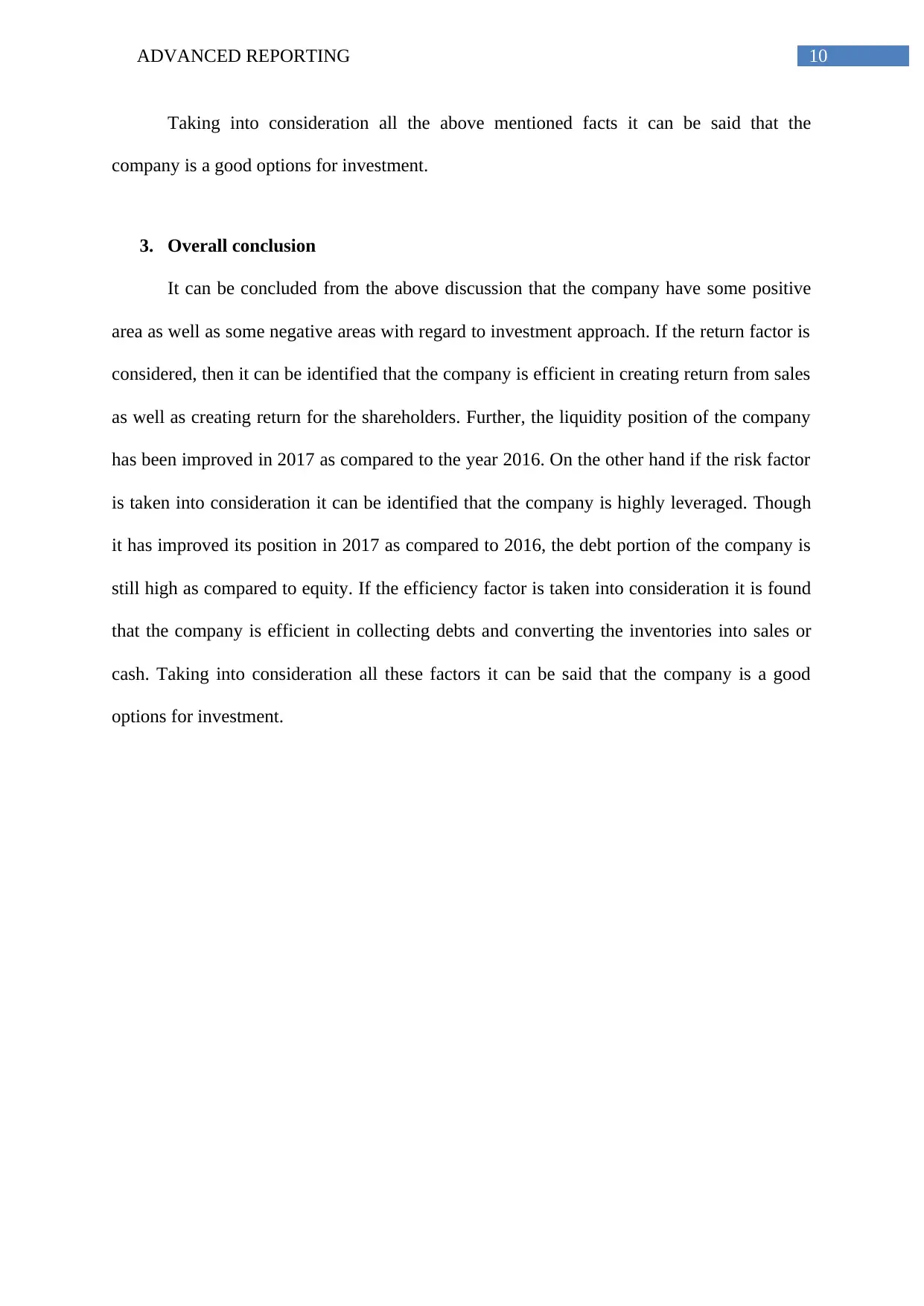
10ADVANCED REPORTING
Taking into consideration all the above mentioned facts it can be said that the
company is a good options for investment.
3. Overall conclusion
It can be concluded from the above discussion that the company have some positive
area as well as some negative areas with regard to investment approach. If the return factor is
considered, then it can be identified that the company is efficient in creating return from sales
as well as creating return for the shareholders. Further, the liquidity position of the company
has been improved in 2017 as compared to the year 2016. On the other hand if the risk factor
is taken into consideration it can be identified that the company is highly leveraged. Though
it has improved its position in 2017 as compared to 2016, the debt portion of the company is
still high as compared to equity. If the efficiency factor is taken into consideration it is found
that the company is efficient in collecting debts and converting the inventories into sales or
cash. Taking into consideration all these factors it can be said that the company is a good
options for investment.
Taking into consideration all the above mentioned facts it can be said that the
company is a good options for investment.
3. Overall conclusion
It can be concluded from the above discussion that the company have some positive
area as well as some negative areas with regard to investment approach. If the return factor is
considered, then it can be identified that the company is efficient in creating return from sales
as well as creating return for the shareholders. Further, the liquidity position of the company
has been improved in 2017 as compared to the year 2016. On the other hand if the risk factor
is taken into consideration it can be identified that the company is highly leveraged. Though
it has improved its position in 2017 as compared to 2016, the debt portion of the company is
still high as compared to equity. If the efficiency factor is taken into consideration it is found
that the company is efficient in collecting debts and converting the inventories into sales or
cash. Taking into consideration all these factors it can be said that the company is a good
options for investment.
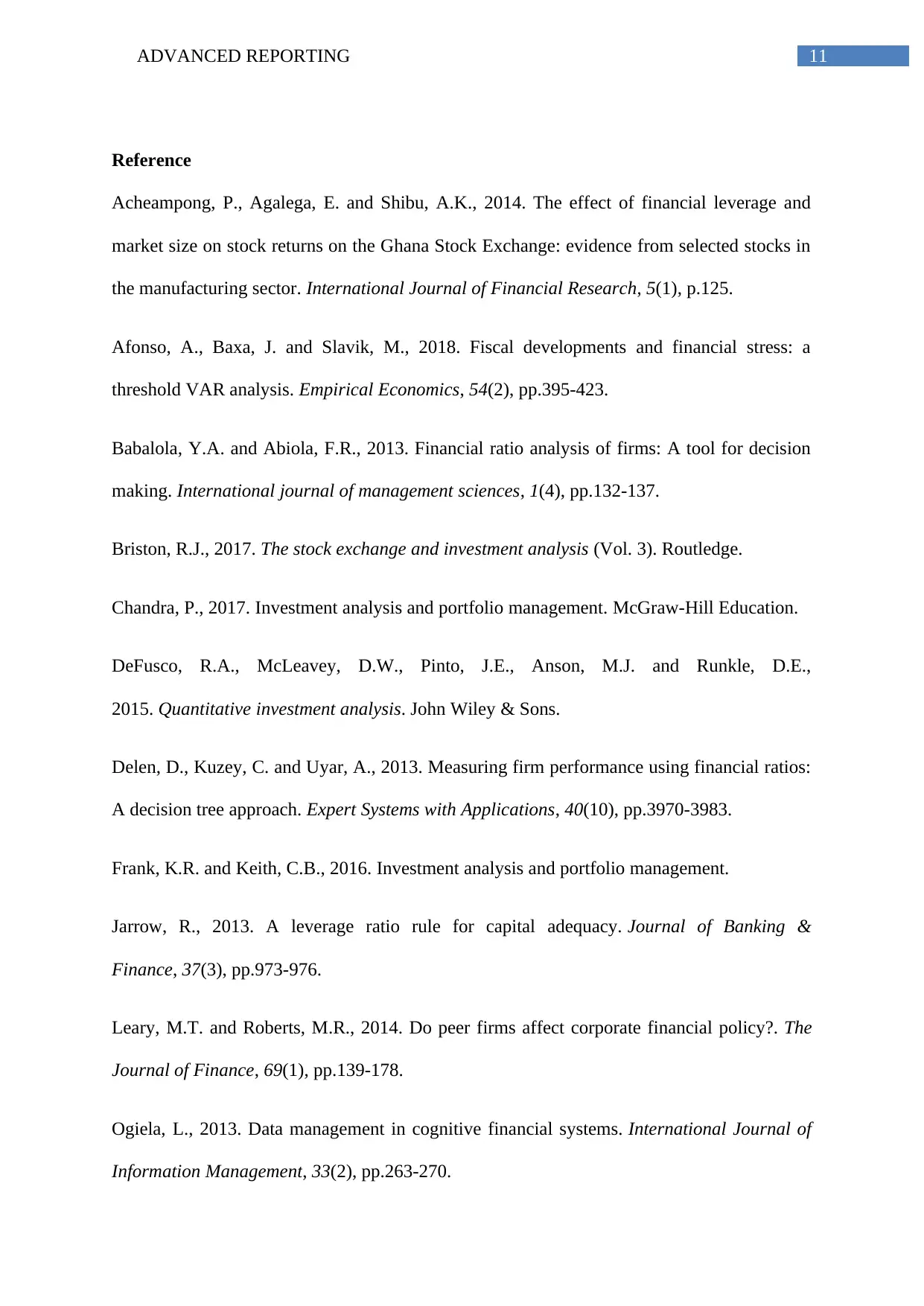
11ADVANCED REPORTING
Reference
Acheampong, P., Agalega, E. and Shibu, A.K., 2014. The effect of financial leverage and
market size on stock returns on the Ghana Stock Exchange: evidence from selected stocks in
the manufacturing sector. International Journal of Financial Research, 5(1), p.125.
Afonso, A., Baxa, J. and Slavik, M., 2018. Fiscal developments and financial stress: a
threshold VAR analysis. Empirical Economics, 54(2), pp.395-423.
Babalola, Y.A. and Abiola, F.R., 2013. Financial ratio analysis of firms: A tool for decision
making. International journal of management sciences, 1(4), pp.132-137.
Briston, R.J., 2017. The stock exchange and investment analysis (Vol. 3). Routledge.
Chandra, P., 2017. Investment analysis and portfolio management. McGraw-Hill Education.
DeFusco, R.A., McLeavey, D.W., Pinto, J.E., Anson, M.J. and Runkle, D.E.,
2015. Quantitative investment analysis. John Wiley & Sons.
Delen, D., Kuzey, C. and Uyar, A., 2013. Measuring firm performance using financial ratios:
A decision tree approach. Expert Systems with Applications, 40(10), pp.3970-3983.
Frank, K.R. and Keith, C.B., 2016. Investment analysis and portfolio management.
Jarrow, R., 2013. A leverage ratio rule for capital adequacy. Journal of Banking &
Finance, 37(3), pp.973-976.
Leary, M.T. and Roberts, M.R., 2014. Do peer firms affect corporate financial policy?. The
Journal of Finance, 69(1), pp.139-178.
Ogiela, L., 2013. Data management in cognitive financial systems. International Journal of
Information Management, 33(2), pp.263-270.
Reference
Acheampong, P., Agalega, E. and Shibu, A.K., 2014. The effect of financial leverage and
market size on stock returns on the Ghana Stock Exchange: evidence from selected stocks in
the manufacturing sector. International Journal of Financial Research, 5(1), p.125.
Afonso, A., Baxa, J. and Slavik, M., 2018. Fiscal developments and financial stress: a
threshold VAR analysis. Empirical Economics, 54(2), pp.395-423.
Babalola, Y.A. and Abiola, F.R., 2013. Financial ratio analysis of firms: A tool for decision
making. International journal of management sciences, 1(4), pp.132-137.
Briston, R.J., 2017. The stock exchange and investment analysis (Vol. 3). Routledge.
Chandra, P., 2017. Investment analysis and portfolio management. McGraw-Hill Education.
DeFusco, R.A., McLeavey, D.W., Pinto, J.E., Anson, M.J. and Runkle, D.E.,
2015. Quantitative investment analysis. John Wiley & Sons.
Delen, D., Kuzey, C. and Uyar, A., 2013. Measuring firm performance using financial ratios:
A decision tree approach. Expert Systems with Applications, 40(10), pp.3970-3983.
Frank, K.R. and Keith, C.B., 2016. Investment analysis and portfolio management.
Jarrow, R., 2013. A leverage ratio rule for capital adequacy. Journal of Banking &
Finance, 37(3), pp.973-976.
Leary, M.T. and Roberts, M.R., 2014. Do peer firms affect corporate financial policy?. The
Journal of Finance, 69(1), pp.139-178.
Ogiela, L., 2013. Data management in cognitive financial systems. International Journal of
Information Management, 33(2), pp.263-270.

12ADVANCED REPORTING
Palepu, K.G., Healy, P.M. and Peek, E., 2013. Business analysis and valuation: IFRS edition.
Cengage Learning.
Robinson, T.R., Henry, E., Pirie, W.L. and Broihahn, M.A., 2015. International financial
statement analysis. John Wiley & Sons.
Ryanair.com., 2018. Official Ryanair website | Book direct for the lowest fares |
Ryanair.com. [online] Available at: https://www.ryanair.com/gb/en/ [Accessed 6 Apr. 2018].
Zack, G.M., 2013. Financial Statement Analysis. Financial Statement Fraud: Strategies for
Detection and Investigation, pp.209-213.
Zhuo-hua, Z.H.O.U., Wen-nan, C.H.E.N. and Zong-yi, Z.H.A.N.G., 2015. Application of
cluster analysis in stock investment.
Palepu, K.G., Healy, P.M. and Peek, E., 2013. Business analysis and valuation: IFRS edition.
Cengage Learning.
Robinson, T.R., Henry, E., Pirie, W.L. and Broihahn, M.A., 2015. International financial
statement analysis. John Wiley & Sons.
Ryanair.com., 2018. Official Ryanair website | Book direct for the lowest fares |
Ryanair.com. [online] Available at: https://www.ryanair.com/gb/en/ [Accessed 6 Apr. 2018].
Zack, G.M., 2013. Financial Statement Analysis. Financial Statement Fraud: Strategies for
Detection and Investigation, pp.209-213.
Zhuo-hua, Z.H.O.U., Wen-nan, C.H.E.N. and Zong-yi, Z.H.A.N.G., 2015. Application of
cluster analysis in stock investment.
Paraphrase This Document
Need a fresh take? Get an instant paraphrase of this document with our AI Paraphraser
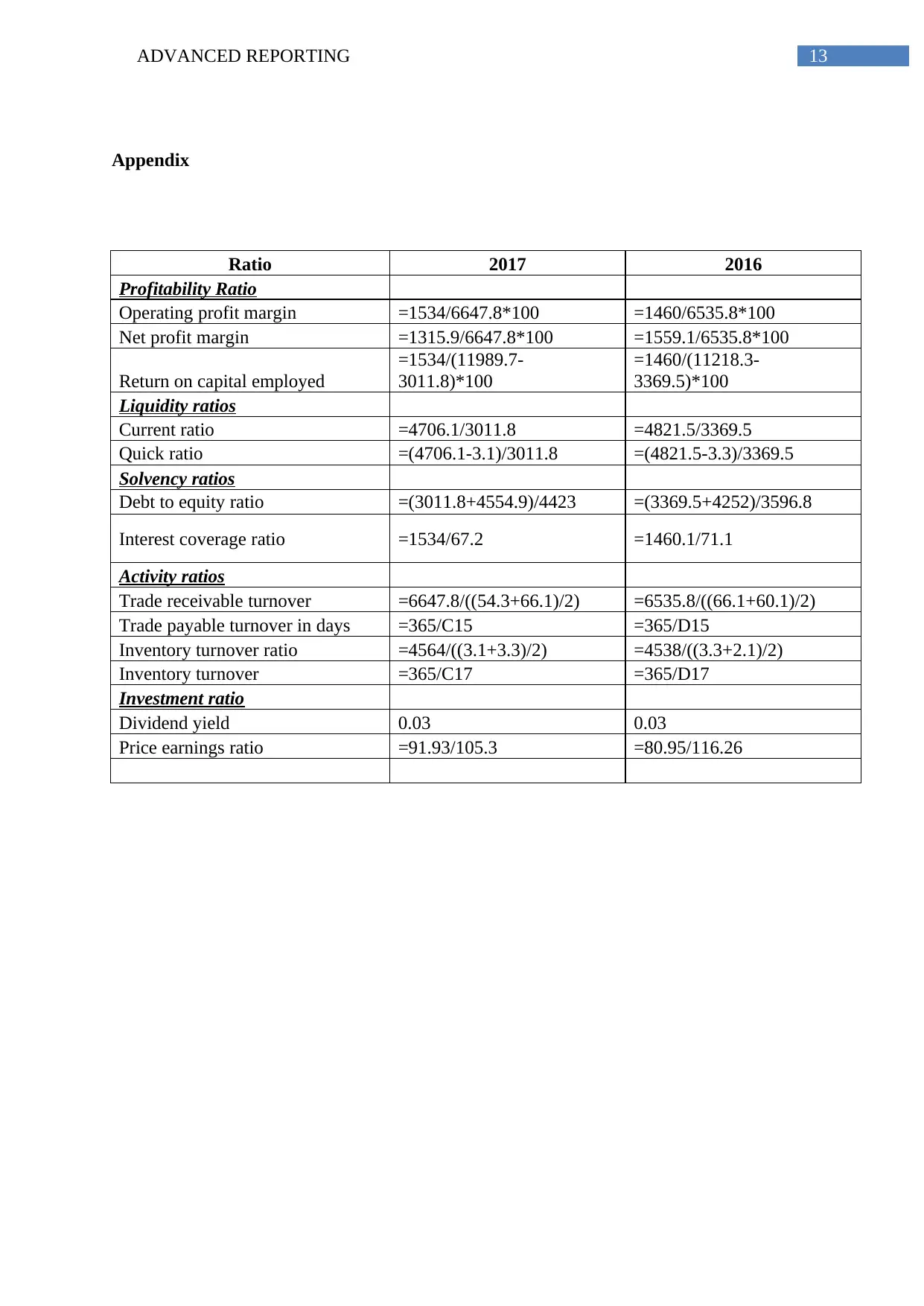
13ADVANCED REPORTING
Appendix
Ratio 2017 2016
Profitability Ratio
Operating profit margin =1534/6647.8*100 =1460/6535.8*100
Net profit margin =1315.9/6647.8*100 =1559.1/6535.8*100
Return on capital employed
=1534/(11989.7-
3011.8)*100
=1460/(11218.3-
3369.5)*100
Liquidity ratios
Current ratio =4706.1/3011.8 =4821.5/3369.5
Quick ratio =(4706.1-3.1)/3011.8 =(4821.5-3.3)/3369.5
Solvency ratios
Debt to equity ratio =(3011.8+4554.9)/4423 =(3369.5+4252)/3596.8
Interest coverage ratio =1534/67.2 =1460.1/71.1
Activity ratios
Trade receivable turnover =6647.8/((54.3+66.1)/2) =6535.8/((66.1+60.1)/2)
Trade payable turnover in days =365/C15 =365/D15
Inventory turnover ratio =4564/((3.1+3.3)/2) =4538/((3.3+2.1)/2)
Inventory turnover =365/C17 =365/D17
Investment ratio
Dividend yield 0.03 0.03
Price earnings ratio =91.93/105.3 =80.95/116.26
Appendix
Ratio 2017 2016
Profitability Ratio
Operating profit margin =1534/6647.8*100 =1460/6535.8*100
Net profit margin =1315.9/6647.8*100 =1559.1/6535.8*100
Return on capital employed
=1534/(11989.7-
3011.8)*100
=1460/(11218.3-
3369.5)*100
Liquidity ratios
Current ratio =4706.1/3011.8 =4821.5/3369.5
Quick ratio =(4706.1-3.1)/3011.8 =(4821.5-3.3)/3369.5
Solvency ratios
Debt to equity ratio =(3011.8+4554.9)/4423 =(3369.5+4252)/3596.8
Interest coverage ratio =1534/67.2 =1460.1/71.1
Activity ratios
Trade receivable turnover =6647.8/((54.3+66.1)/2) =6535.8/((66.1+60.1)/2)
Trade payable turnover in days =365/C15 =365/D15
Inventory turnover ratio =4564/((3.1+3.3)/2) =4538/((3.3+2.1)/2)
Inventory turnover =365/C17 =365/D17
Investment ratio
Dividend yield 0.03 0.03
Price earnings ratio =91.93/105.3 =80.95/116.26
1 out of 14
Related Documents
Your All-in-One AI-Powered Toolkit for Academic Success.
+13062052269
info@desklib.com
Available 24*7 on WhatsApp / Email
![[object Object]](/_next/static/media/star-bottom.7253800d.svg)
Unlock your academic potential
© 2024 | Zucol Services PVT LTD | All rights reserved.





